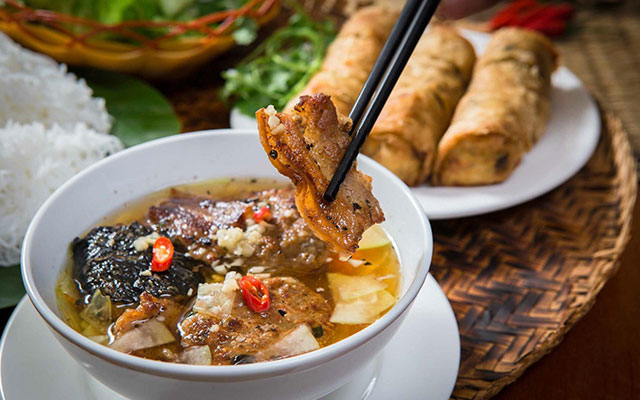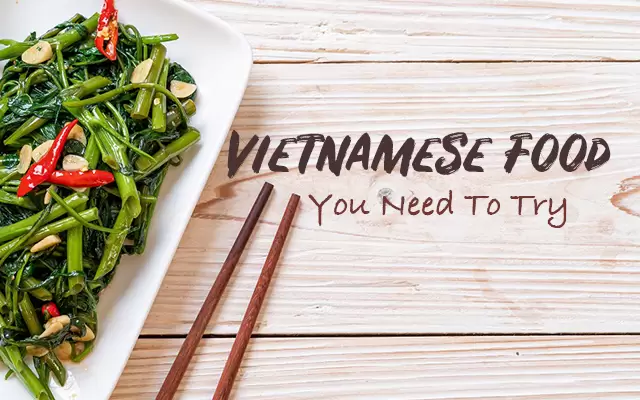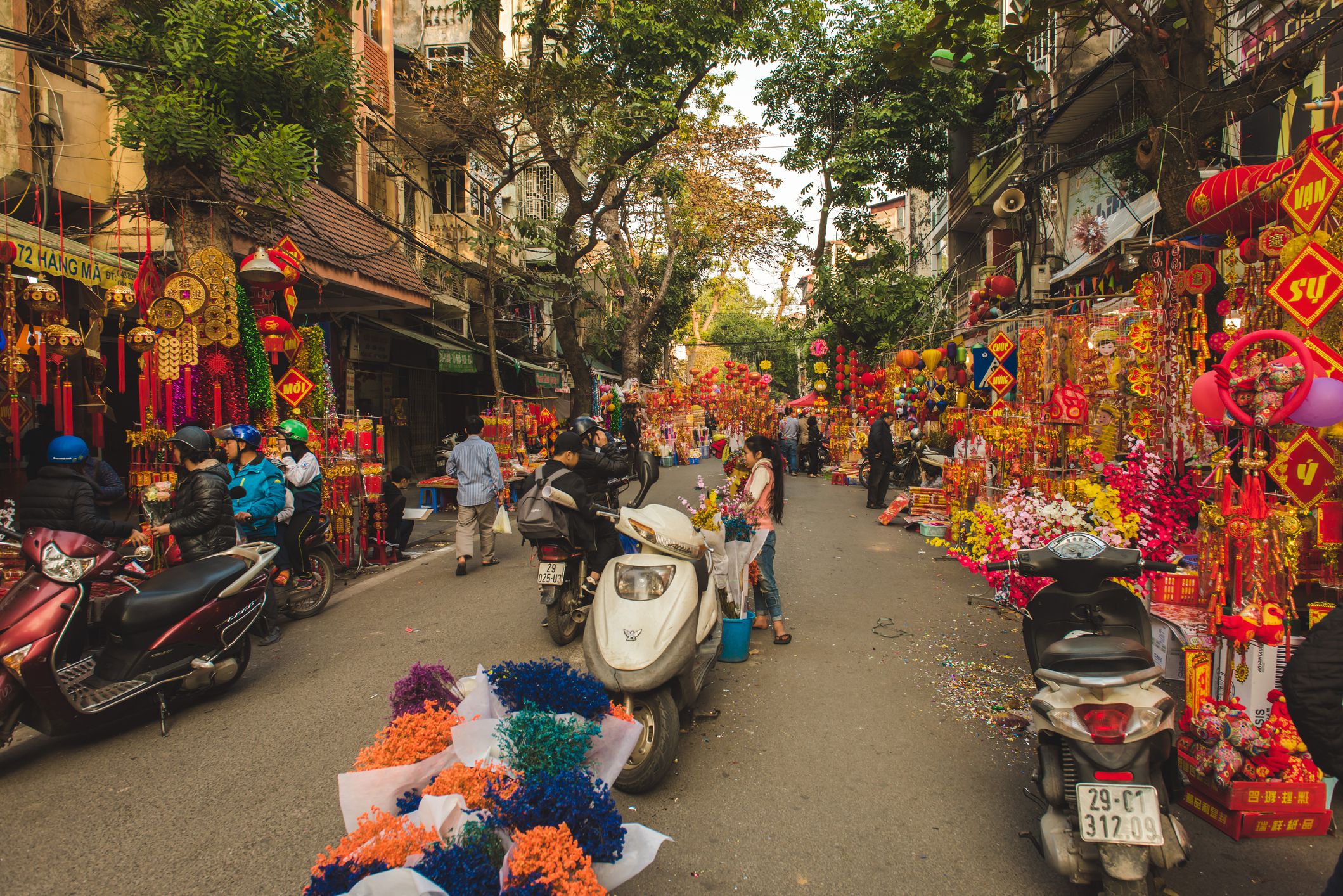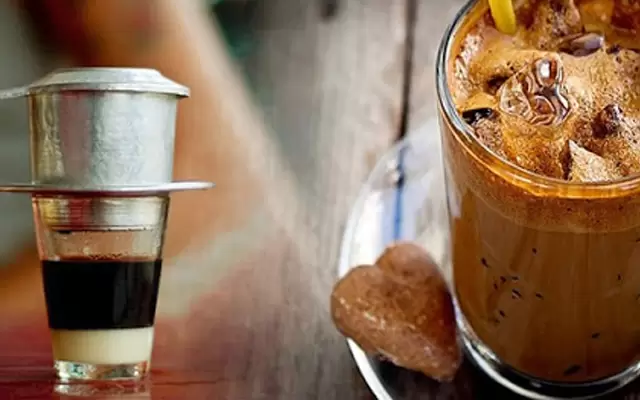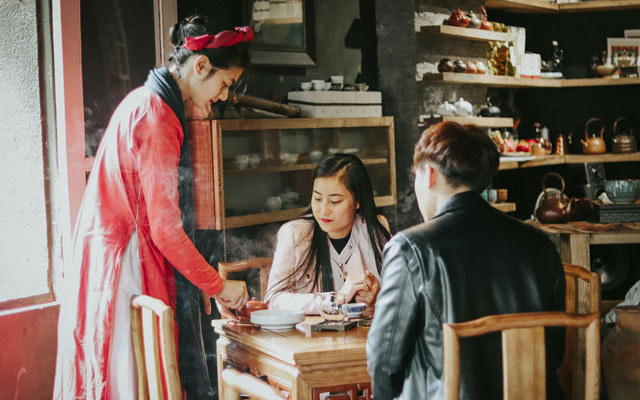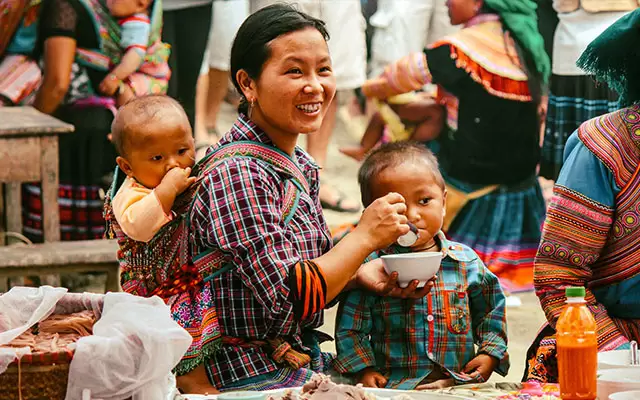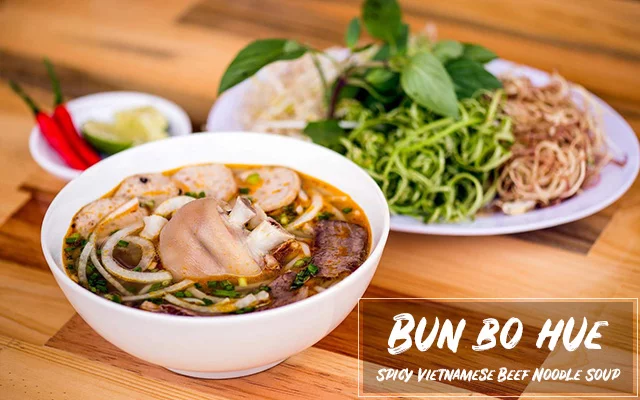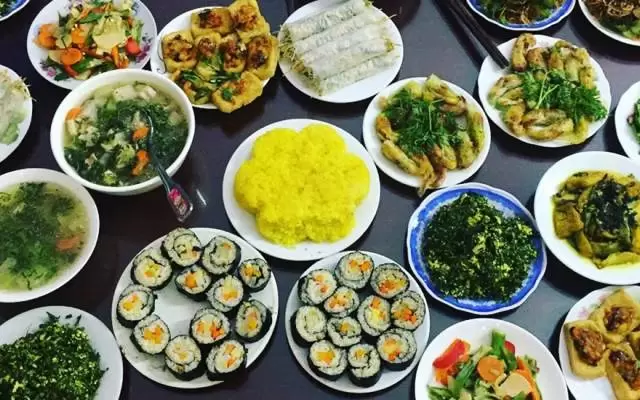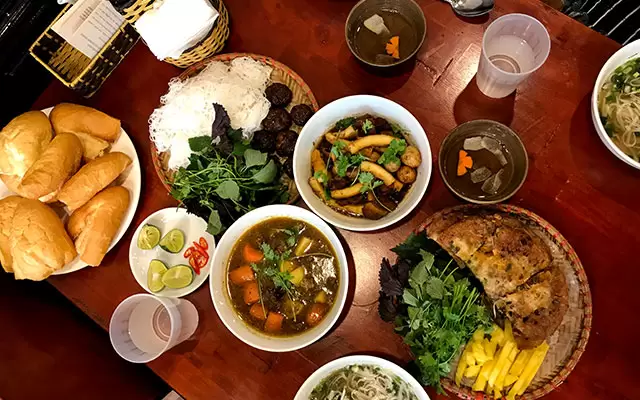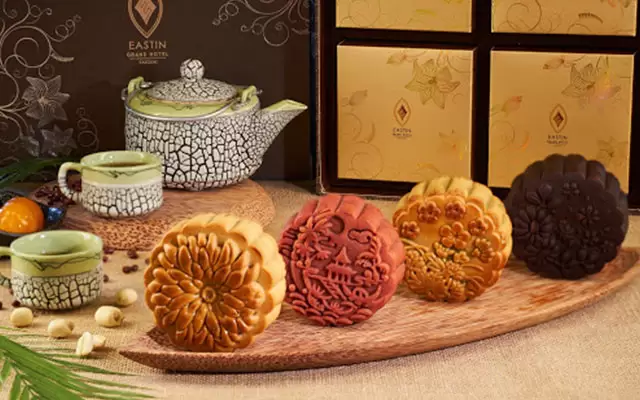Vietnamese Cuisine: A Delicious Journey through Flavors and Traditions
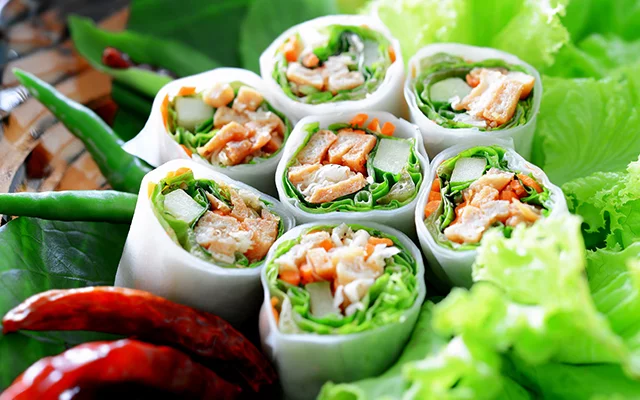
Spring rolls are a delightful Vietnamese dish that tourists love and have become a staple of the country's cuisine.
Vietnamese cuisine is a symphony of fresh ingredients, fragrant herbs, and bold spices. From the steaming bowls of phở to the crispy bánh mì sandwiches, Vietnamese food tantalizes taste buds and captures the essence of Southeast Asian flavors. This guide will be your passport to exploring this culinary wonderland. We’ll delve into the must-try dishes, regional variations, historical influences, and tips for recreating these delights at home.
Table of Contents
Must-Try Dishes: The Stars of Vietnamese Cuisine
Vietnamese cuisine is a vibrant and diverse culinary tradition that reflects the country’s rich cultural history and geography. From the bustling streets of Hanoi to the serene beaches of Phu Quoc, Vietnam offers a culinary journey that captivates the taste buds with its fresh ingredients, delicate flavors, and unique cooking techniques. Here are some of the must-try dishes that showcase the best of Vietnamese cuisine:
Pho (rice noodle soup)
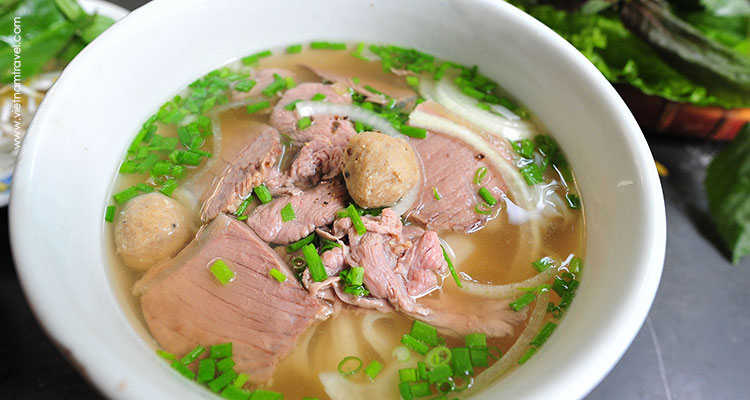
Beef noodle – The most popular breakfast in Vietnam
Listed as one of the world’s 50 best foods by CNN, “pho” is definitely a must-try dish when you come to Vietnam, especially in the capital of Hanoi. It is basically rice noodles served with broth and beef or chicken. Since broth is the star of this dish, Northern people put much effort into the first step of choosing ingredients to cooking techniques. It is normally made from 10 – 15 different ingredients, including beef ribs, ginger, cinnamon, black pepper, star anise and many other spices to make it aromatic, sweet and clear.
“Pho” is served both in street vendors or fine restaurants and you can have “pho” for breakfast, lunch or dinner. It is much better to add in the bowl of “pho” a little lemon juice, chili sauce and garlic – based on your own personal taste.
Phở is the quintessential Vietnamese dish, a fragrant and hearty noodle soup that has gained international acclaim. It typically consists of broth, rice noodles, herbs, and meat, usually beef (phở bò) or chicken (phở gà). The broth is simmered for hours with bones, cinnamon, star anise, and other spices, creating a depth of flavor that is both soothing and invigorating. Phở is often garnished with fresh herbs, bean sprouts, lime, and chili, allowing diners to customize their bowl to their taste.
Banh Mi (Vietnamese bread)
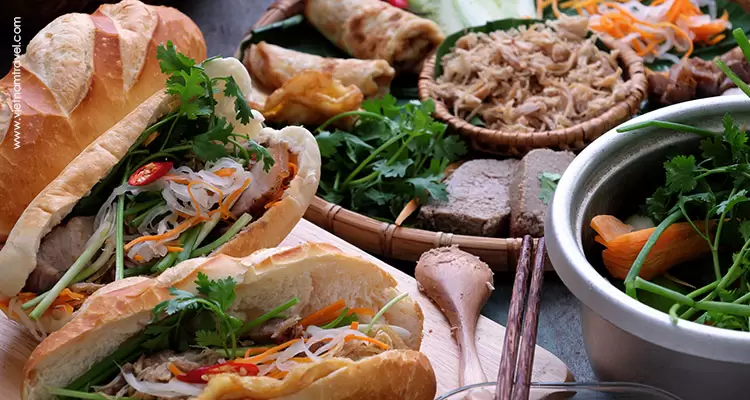
“Banh mi” is a popular breakfast for Vietnamese people
“Banh mi” is one of the most famous street foods in Vietnam and you can easily it in every corners of streets. It is filled with many different kinds of ingredients such as grilled pork, grilled chicken, pate, carrot, fried egg, sausage, coriander, cucumber, tomato, chili sauce, ….
Bánh mì is a beloved Vietnamese sandwich that embodies the country’s colonial history and culinary fusion. It features a crisp baguette filled with various ingredients such as pork, pâté, pickled vegetables, cilantro, and chili. The contrast between the crunchy bread and the savory, tangy fillings makes bánh mì a perfect snack or light meal, enjoyed by locals and travelers alike.
Bun Cha (vermicelli with grilled marinated pork)
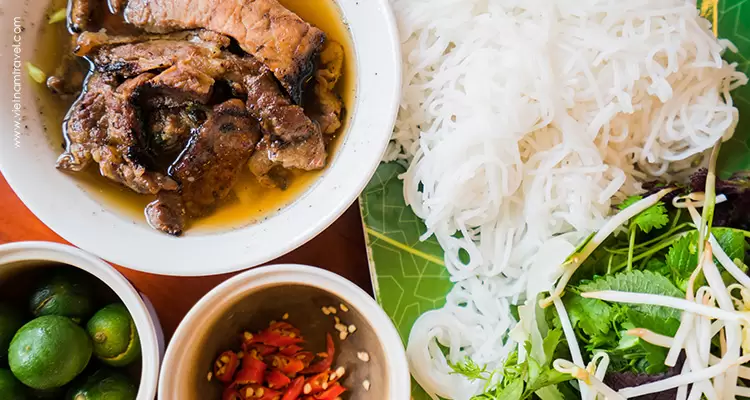
Vermicelli & BBQ pork at a restaurant in Le Van Huu Street in Hanoi, Vietnam
“Bun cha” has become more famous all over the world when the US President Barack Obama and Anthony Bourdain took this dish when visiting Vietnam in 2016. It is blended with vermicelli, grilled pork on bamboo sticks, and sweet-and-sour sauce. Fragrant herbs are often added to create an attractive fragrance and taste.
A specialty of Hanoi, bún chả features grilled pork patties and slices served over a bed of rice noodles, accompanied by fresh herbs and a tangy dipping sauce made of fish sauce, vinegar, sugar, and lime juice. The combination of smoky, savory pork with the fresh, vibrant flavors of the herbs and dipping sauce makes bún chả a delightful and satisfying dish.
Bun bo Hue (Hue vermicelli beef soup)
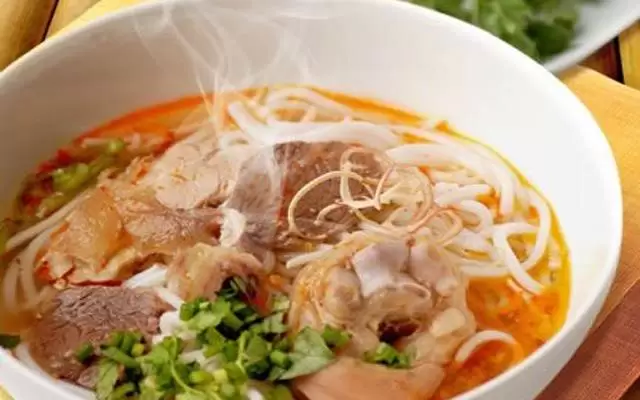
A Vietnamese spicy beef noodle soup – “bun bo Hue” is originated from Hue City in Central Vietnam
“Bun bo Hue” is a popular Vietnamese noodle soup, and one of the most typical foods in Hue. Unlike “pho”, this dish is a combination of sweet, sour and spicy and the fine combination of ingredients makes the food famous. A bowl of “bun bo Hue” is added thin slices of beef shank, chunks of boiled oxtail, pig’s knuckles, blood,… and rich broth. It is commonly served with a plenty of herbs like sprouts, lime wedges, cilantro sprigs, onions, and sliced banana blossom.
Bún bò Huế is a spicy beef noodle soup originating from the central city of Huế. It features a rich and aromatic broth flavored with lemongrass, shrimp paste, and chili, and includes slices of beef, pork knuckles, and sometimes congealed pig’s blood. The bold flavors and hearty ingredients make bún bò Huế a favorite among those who enjoy a bit of heat in their meals.
Cao Lau (Hoi An)
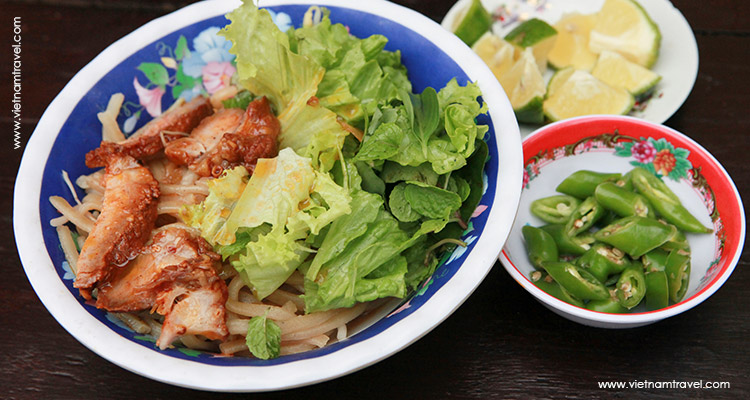
Cao Lau is an essence of Hoi An cuisine
Cao Lau is a specialty dish of Hoi An. The special feature of Cao Lau is its noodle which must be made with the water from Ba Le well, a one-hundred-year-old well in Hoi An to knead the dough. Besides, the rice to make noodle is of the local rice variety. The rice used is neither freshly harvested nor too aged. This dish comprises of the signature noodles, thinly slices of barbecue pork, pork crackling, bean sprouts, crispy croutons, lettuce and herbs, it is then finished with a spoonful of stock.
Cao lầu is a regional dish from Hội An, known for its unique and complex flavors. It consists of chewy noodles, slices of pork, fresh herbs, and crispy croutons, all brought together with a small amount of broth. The noodles are traditionally made using water from a specific local well, giving them a distinctive texture and taste that cannot be replicated elsewhere.
Goi Cuon (Spring Rolls)
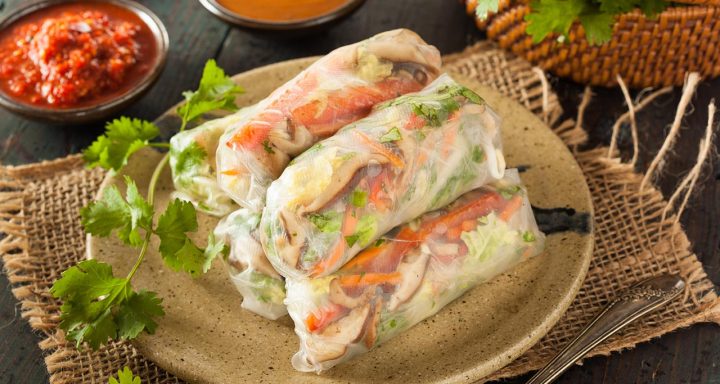
Vietnamese spring rolls are a beloved dish among tourists, attracting them to the country’s rich culinary scene.
Gỏi cuốn, or fresh spring rolls, are light and refreshing rolls made with rice paper and filled with shrimp, pork, fresh herbs, rice vermicelli, and vegetables. They are typically served with a side of peanut sauce for dipping. Unlike fried spring rolls, gỏi cuốn are not cooked, which preserves the fresh flavors and textures of the ingredients.
Banh Xeo
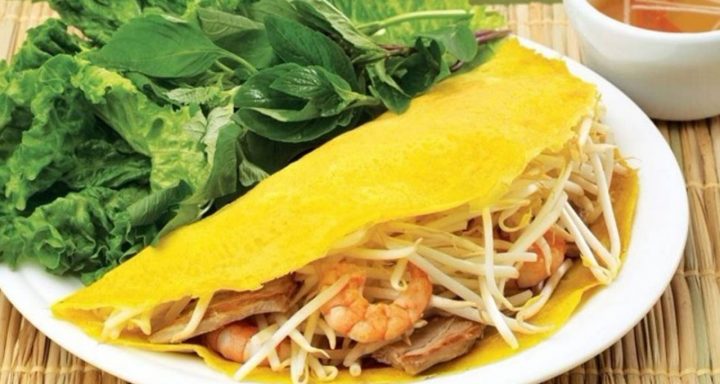
The crispy turmeric-dyed crepe of Banh Xeo bursts with savory fillings of shrimp, pork, and bean sprouts, all wrapped in fresh lettuce leaves and herbs for a delightful Vietnamese street food experience.
Bánh xèo, or Vietnamese pancakes, are savory crepes made from rice flour, turmeric, and coconut milk, filled with shrimp, pork, bean sprouts, and green onions. They are usually served with fresh lettuce and herbs, which are used to wrap pieces of the pancake before dipping them in a tangy fish sauce. The contrast between the crispy pancake and the fresh herbs creates a delightful eating experience.
Cha Ca La Vong
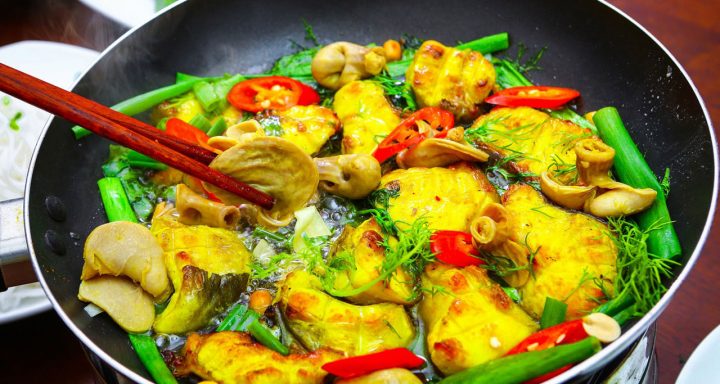
Enjoy Hanoi’s sizzling Cha Ca La Vong, a dish of turmeric-marinated white fish cooked on a grill and served with rice noodles and fresh herbs.
Hailing from Hanoi, chả cá lã vọng is a unique dish featuring grilled fish marinated in turmeric and dill. The fish is cooked tableside with dill and green onions, and served with rice noodles, peanuts, and a fish sauce-based dipping sauce. The aromatic herbs and spices make this dish a standout in Vietnamese cuisine.
Hu Tieu
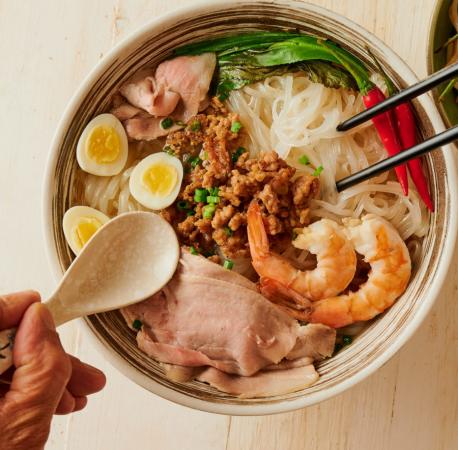
A steaming bowl of Hu Tieu, a Vietnamese noodle soup dish, features thin rice noodles in a flavorful broth, often served with sliced pork, shrimp, and fresh herbs.
Hủ tiếu is a versatile noodle soup that varies by region. It can be served with a clear and light broth or a richer, more flavorful one, and is typically accompanied by a variety of meats such as pork, shrimp, and quail eggs. The noodles can be either rice noodles or egg noodles, making each bowl a unique and customizable experience.
Banh Cuon
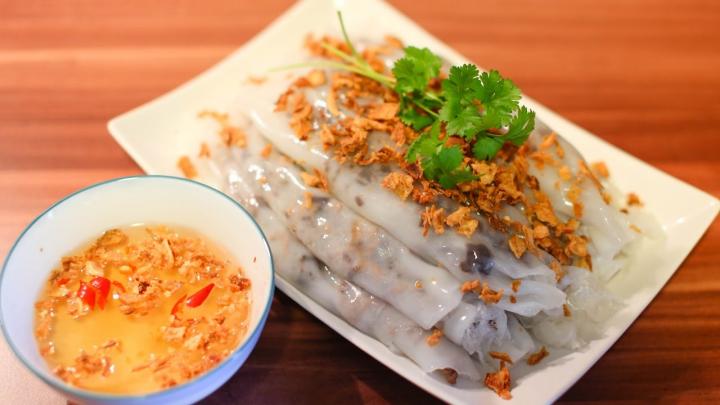
Bánh Cuốn are delicate Vietnamese steamed rice rolls, often filled with savory pork and served with a nuoc cham dipping sauce for a delightful and refreshing meal.
Bánh cuốn are delicate steamed rice rolls filled with a mixture of minced pork and mushrooms. They are served with fried shallots, fresh herbs, and a side of fish sauce for dipping. The soft, silky texture of the rice rolls paired with the savory filling makes bánh cuốn a popular breakfast dish.
Vietnamese cuisine offers a delightful array of dishes that highlight the country’s culinary diversity and creativity. Whether you’re savoring a bowl of phở in a bustling street market or enjoying the delicate flavors of gỏi cuốn by the riverside, each dish tells a story of Vietnam’s rich cultural heritage and love for fresh, flavorful food. So, embark on a culinary adventure and discover the stars of Vietnamese cuisine that have captivated food lovers around the world.
The Influences on Vietnamese Cuisine
Vietnamese cuisine is a delicious and unique blend of flavors, thanks to the country’s long history and interaction with different cultures. Here’s a look at some of the biggest influences on Vietnamese food:
China
For over 1,000 years, China ruled Vietnam, leaving a significant mark on its cuisine. Stir-frying, noodles, and the use of chopsticks are all legacies of Chinese influence. Chinese cuisine has had a profound impact on Vietnamese food, especially in the northern regions due to historical interactions and geographical proximity. Key contributions include:
- Noodles and Rice Dishes: Pho, Vietnam’s iconic noodle soup, and fried rice dishes are reminiscent of Chinese culinary styles.
- Stir-frying Techniques: Many Vietnamese dishes are stir-fried, reflecting Chinese cooking methods.
- Use of Soy Sauce: While fish sauce is quintessential in Vietnamese cuisine, soy sauce, a staple in Chinese cooking, is also widely used.
- Dim Sum: Small dishes similar to dim sum, like bánh bao (steamed buns) and bánh cuốn (steamed rice rolls), are popular in Vietnam.
Southeast Asian Neighbors
Countries like Laos, Cambodia, and Thailand have also influenced Vietnamese cooking. They introduced ingredients like coconut milk, spices, chilies, and egg noodles.
Vietnam shares culinary similarities with its Southeast Asian neighbors, reflecting regional trade and cultural exchanges. Influences from this region include:
- Herbs and Spices: The use of fresh herbs like cilantro, mint, and basil, along with spices such as lemongrass and turmeric, is common in Southeast Asian cooking.
- Fish Sauce: This essential condiment is used throughout Southeast Asia, imparting a distinct umami flavor to Vietnamese dishes.
- Coconut Milk: Widely used in Southeast Asian cuisine, coconut milk features prominently in Vietnamese curries and desserts.
- Fermented Foods: The tradition of fermenting foods, such as pickled vegetables and sauces, is a shared characteristic across the region.
France
French colonial rule from 1887 to 1954 left its mark on Vietnamese cuisine as well. The French introduced baguettes, which are now a staple food in Vietnam, as well as coffee, pate, and dairy products. You’ll see these influences in dishes like bánh mì (Vietnamese sandwiches) and bò bún (beef noodle soup with a French-inspired broth).
The French colonial period left a significant mark on Vietnamese cuisine, blending French techniques and ingredients with local traditions. Notable influences include:
- Banh Mi: This iconic Vietnamese sandwich features a French baguette filled with Vietnamese ingredients like pickled vegetables, cilantro, and various meats.
- Pâté: Often used in banh mi, this spread is a direct influence from French cuisine.
- Coffee Culture: Introduced by the French, coffee has become a staple in Vietnam, with unique preparations like cà phê sữa đá (iced coffee with condensed milk).
- Baking Techniques: The French brought baking techniques and pastries, influencing Vietnamese desserts and bread-making practices.
India
Indian influence arrived in Vietnam through trade with Southeast Asian countries. This influence can be seen in the use of spices like turmeric, coriander, and cumin, as well as in dishes like curry.
- Curries: Vietnamese curries, like cà ri gà (chicken curry), have their roots in Indian culinary traditions, brought through cultural exchanges and migration.
- Spices: The use of turmeric, cumin, and coriander in Vietnamese dishes indicates Indian influence, especially in the southern regions.
- Vegetarian Dishes: Indian cuisine’s vegetarian emphasis has influenced Vietnamese Buddhist cuisine, resulting in a variety of vegetarian dishes.
Character of Vietnamese Cuisine
Vietnamese cuisine is renowned for its balance of flavors, fresh ingredients, and diverse culinary traditions. Here are some key characteristics that define Vietnamese cuisine:
- Balance of Flavors:
- Vietnamese dishes are known for their harmonious balance of sweet, sour, salty, and spicy flavors. This balance is often achieved using ingredients like fish sauce, lime juice, sugar, and chili.
- Fresh Ingredients:
- Fresh herbs and vegetables are essential components of Vietnamese cuisine. Common herbs include cilantro, mint, basil, and perilla leaves. Vegetables like lettuce, bean sprouts, and cucumber are often served raw or lightly cooked.
- Rice and Noodles:
- Rice is a staple in Vietnamese cuisine, served in various forms such as steamed rice, sticky rice, and rice noodles. Noodle soups, like Pho and Bun Rieu, are popular dishes featuring different types of rice noodles.
- Herbs and Aromatics:
- Vietnamese dishes heavily incorporate aromatics such as garlic, ginger, lemongrass, and shallots. These ingredients add depth and complexity to the flavors.
- Nuoc Mam (Fish Sauce):
- Fish sauce is a fundamental seasoning in Vietnamese cooking, used both as a condiment and as an ingredient in marinades, soups, and dipping sauces.
- Light and Healthy:
- Many Vietnamese dishes are light and healthy, focusing on fresh vegetables, lean proteins, and minimal use of oil. The cuisine often emphasizes steaming, boiling, and grilling over frying.
- Street Food Culture:
- Street food plays a significant role in Vietnamese culinary culture. Popular street food items include Banh Mi (Vietnamese sandwich), Goi Cuon (spring rolls), and Bun Cha (grilled pork with noodles).
- Regional Variations:
- Vietnamese cuisine varies by region. Northern dishes tend to be less spicy and more subtle, while central Vietnamese food is known for its bold and spicy flavors. Southern cuisine often includes sweeter and more diverse dishes due to the region’s abundance of fruits and vegetables.
- Use of Condiments:
- Condiments are crucial in Vietnamese dining. Common condiments include pickled vegetables, chili sauce, hoisin sauce, and soy sauce, allowing diners to customize their dishes.
- Broths and Soups:
- Vietnamese cuisine features a variety of broths and soups, often simmered for hours to develop rich flavors. Pho, the iconic Vietnamese noodle soup, is a prime example, made with a fragrant broth of beef or chicken.
- Emphasis on Presentation:
- Presentation is important in Vietnamese cuisine. Dishes are often beautifully arranged, with attention to color, texture, and garnishes to enhance visual appeal.
Vietnamese cuisine’s emphasis on fresh ingredients, balanced flavors, and healthy preparation methods makes it unique and beloved worldwide.
Combination of Yin & Yang
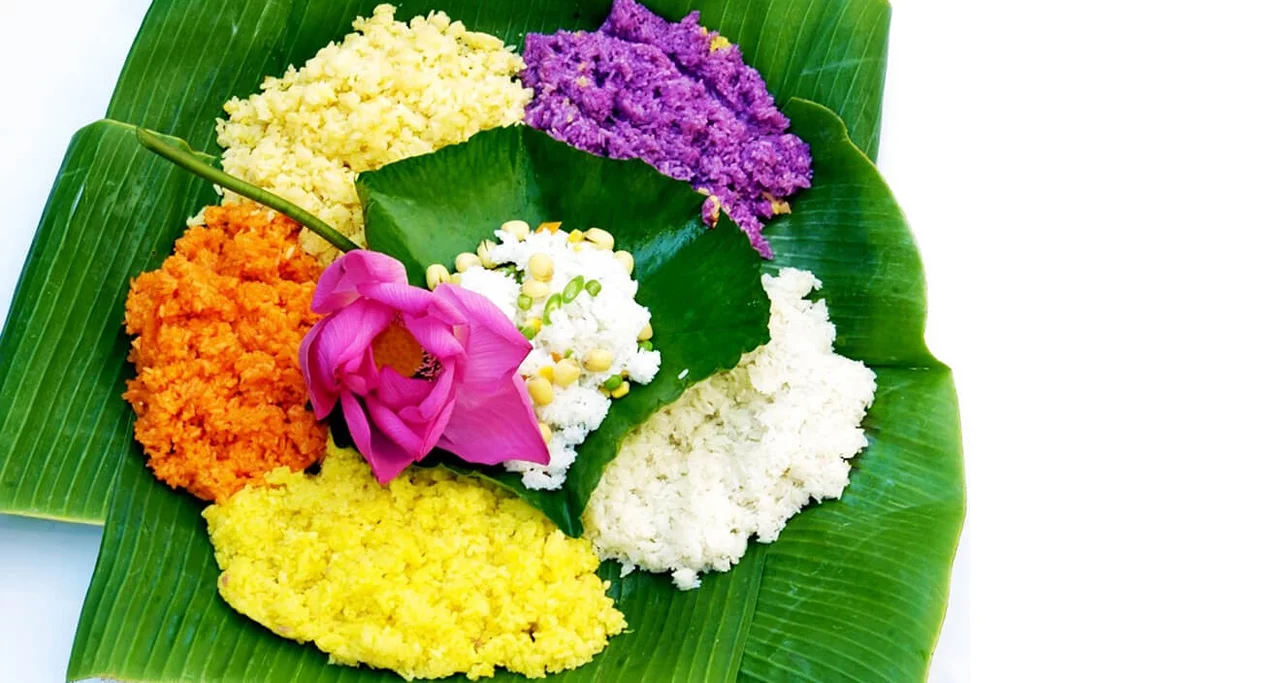
5 color sticky rice of Dao tribe
Vietnamese cuisine, like many other Asian countries, emphasizes the balance between yin and yang, which is beneficial for the body. When preparing Vietnamese dishes, the cook will combine yin – cool ingredients with yang – hot ones to make a balance. A dish with “cool” properties is served with “hot” spices and vice versa. For example, seafood (cool) is often cooked with hot chili, ginger and lemongrass (hot) or duck meat comes with ginger… Moreover, certain dishes are served in their respective seasons to provide the contrast in temperature between the heat of the food and environment.
Low fat in each cooking
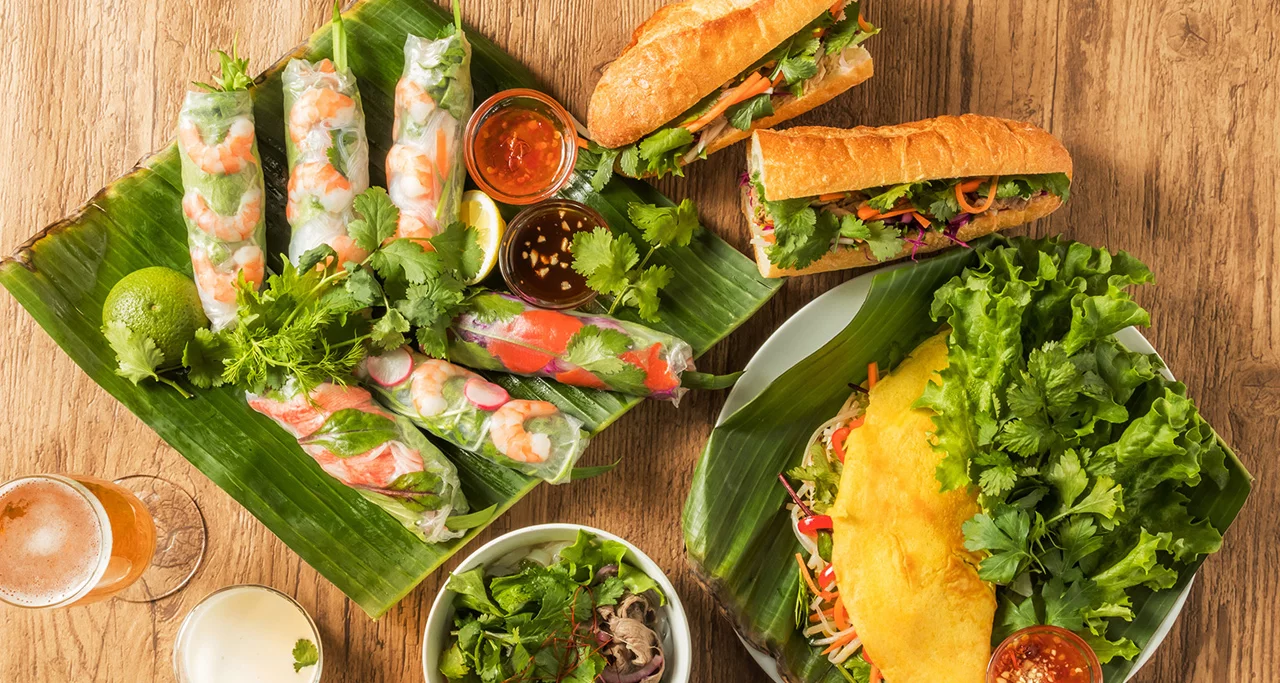
Fresh spring rolls is one of the most healthy dishes with low fat and calories
Unlike Western cuisine where meat is a main ingredients or Chinese dishes with a bit excessive use of oil, Vietnamese cuisine features with low quantity of fat. The dishes are mainly boiled, steamed, stewed, braised… in the aim of remaining the nutrients of the ingredients. Vegetables and herbs are widely used to provide complex flavors and healthiness. Vietnam cuisine is regarded as one of the healthiest cuisines all over the world.
Rice
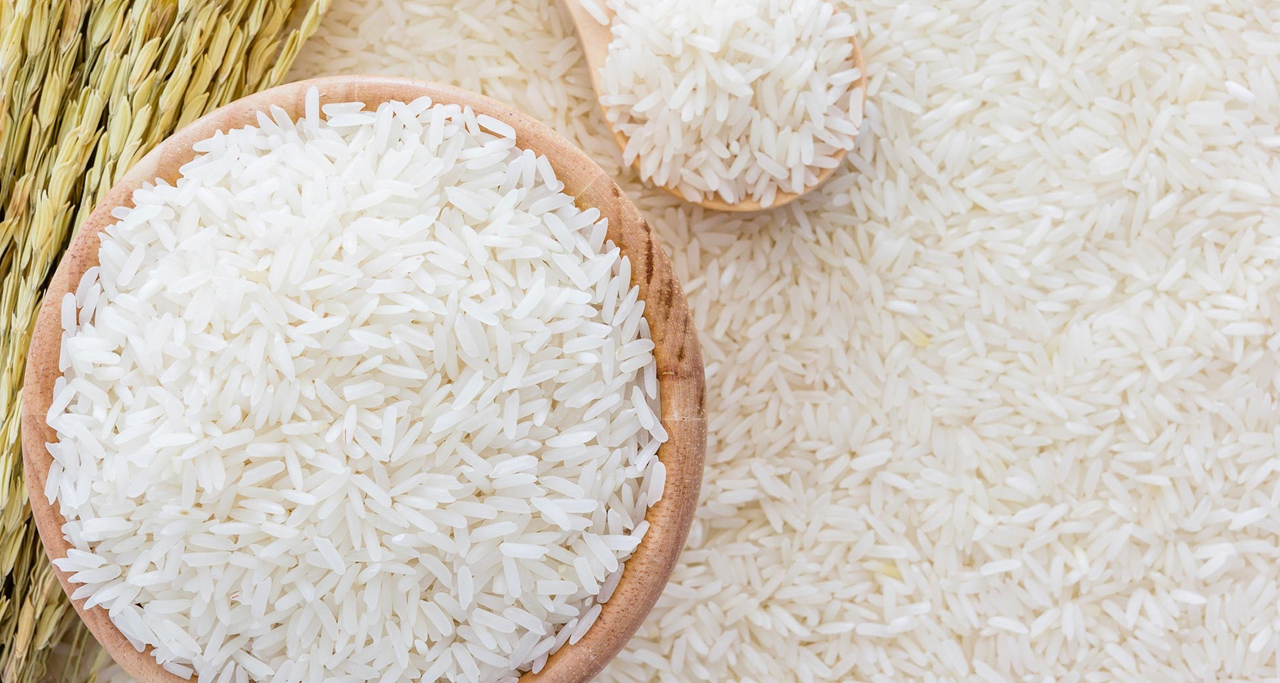
White rice seeds before cooking
Vietnam is the second rice exporter in the world, after Thailand and Mekong Delta in Southern Vietnam is a rice bowl of the country. As a result, rice plays an important role in Vietnamese cuisine. Locals from generations to generations have been familiar with rice-based meals, accompanied by a variety of vegetable dishes, stir-fried meat or fish since their childhood. Rice appears at breakfast, lunch, dinner and dessert with many its variants such as noodles, vermicelli, rice paper…
Fish sauce
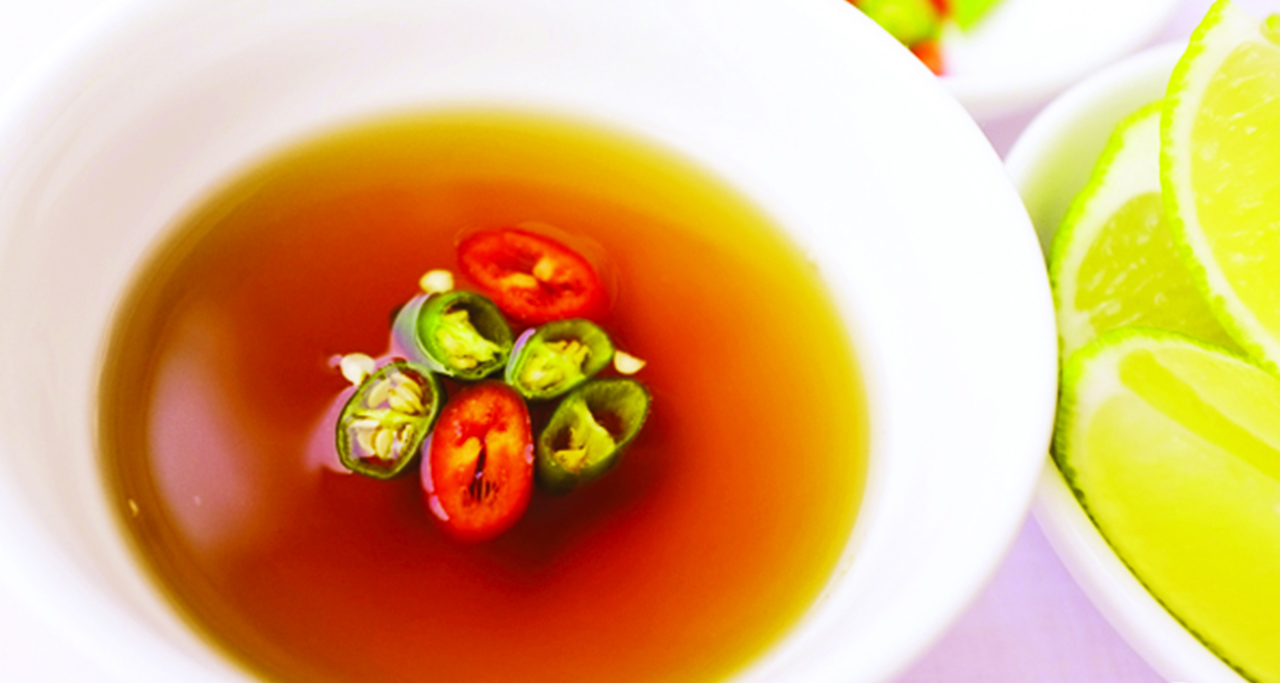
Fish sauce, a typical sauce of Vietnamese cooking
Fish sauce or “nuoc mam” is one of major spices of Vietnamese cuisine. Made from fermented anchovies and salt, fish sauce is used in almost Vietnamese dishes to increase sweet and salty flavors to the food. Besides adding or marinating directly in cooking procession, it is used to make dipping sauce. Each different dish will come along with a different dipping sauce but in general it includes lime juice, sugar, chili, garlic… mixed in distinct proportions. It might be considered as the soul of the dish, so no experience of Vietnamese cuisine is complete without a taste of “nuoc mam”.
Phu Quoc Fish Sauce, a top brand known for its rich flavor and aroma, is traditionally produced in factories on Phu Quoc Island using time-honored fermentation techniques.
Sharing style
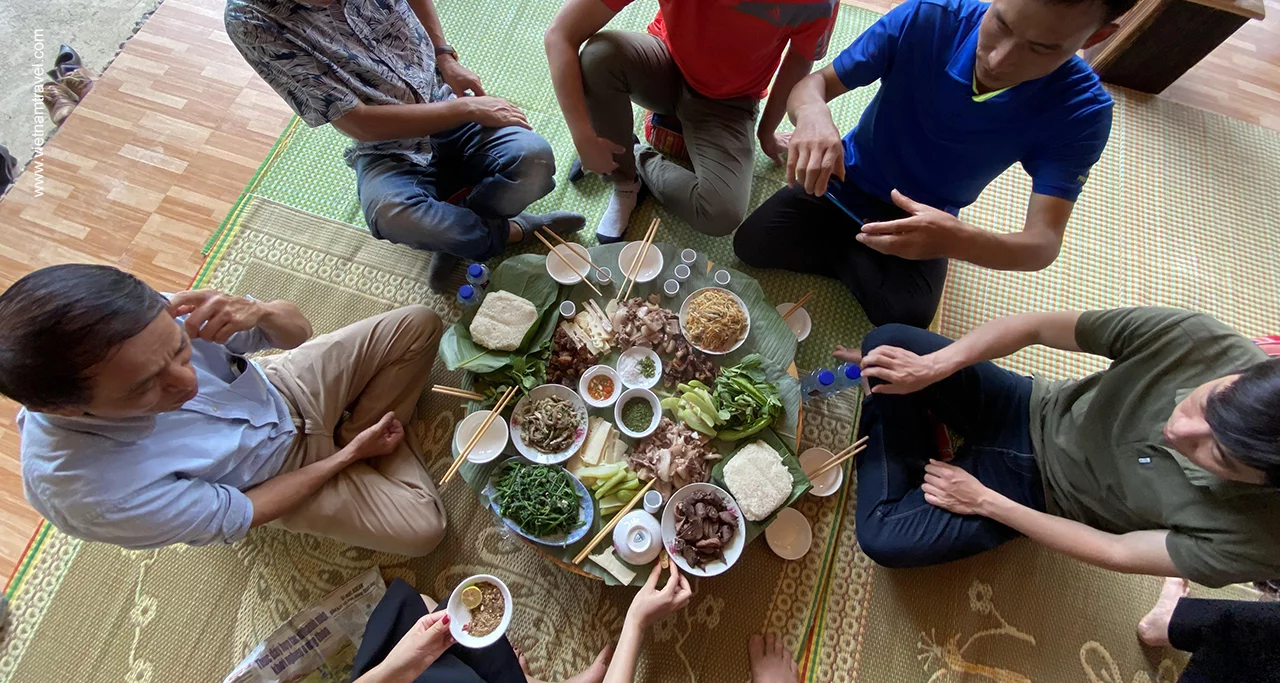
Family sharing style. Dining is great family time
In a typical Vietnamese meal, all dishes are placed in a big round tray, in the center of table and all members of family will join the meal together. While eating, people can share opinions about the dishes and talk about daily basic topics in the eating time. This is a way family members interacts and bonds family relationship. If you have chance to join a meal with local family, you might be surprised when witnessing all family members using a same bowl of dipping sauce. It is one of the unique characteristics of Vietnamese food culture and also express the unity and sharing.
Diversity of Vietnamese Cuisine by Region
Vietnam is an agricultural country belonging to a tropical monsoon region. The country is divided into 3 distinct part: North, Central and South, along with 54 ethnic groups and each region has its own typical taste and flavor. This contributes to rich and diverse Vietnamese cuisine. However, there are quite a lot of things in common like the use of some traditional spices such as fish sauce, shrimp paste, soy sauce, rice and rice-products.
Vietnam’s regional cuisine reflects its diverse geography and cultural influences, offering a rich tapestry of flavors and ingredients that define its culinary landscape.
Northern Cuisine – light and balanced
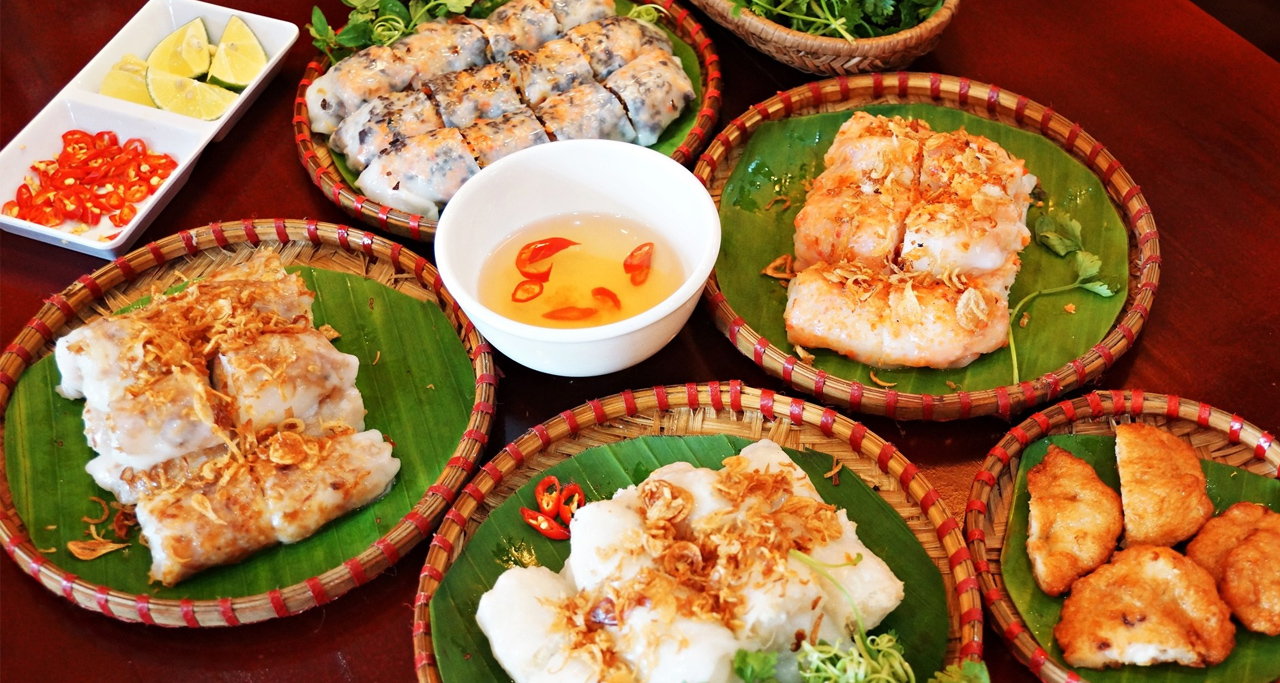
Savory Rolled Cakes or “banh cuon” is served with dipping fish sauce
Northern cuisine is not biased towards any particular flavor: sour, spicy, salty, sweet or bitter. It is relatively light and balanced thanks to the subtle combination of many different flavoring ingredients, in which fish sauce, shrimp paste and limes are particularly popular. Besides, the foods in the region are often less spicy, fatty and sweet, compared to those of other regions in the country though the climate is colder. Northern people tend to consume a fair amount of vegetables and freshwater fishery such as shrimp, squid, crab, fish, clam and other shellfish…. The use of meats such as pork, beef, and chicken were relatively limited in the past.
Being rather reserved, Northern dishes adamantly follow the recipes of their predecessors since they value traditions and customs, and they are convinced that the recipes are the best, because of the experience accumulate throughout generations. Moreover, the characteristics of Northern cuisine are also reflected through holidays, like Tet Holiday, when it is always required to have “four bowls and six dishes” on the table with extremely elaborate preparation and eye-catching decoration. Hanoi’s cuisine can be seen as a representative of North’s with many famous delicacies such as “pho” (rice noodle), “bun cha” (vermicelli with grilled marinated pork), “cha ca La Vong” (grilled fish with turmeric and dill), egg coffee,…
Central Cuisine – spicy and delicate
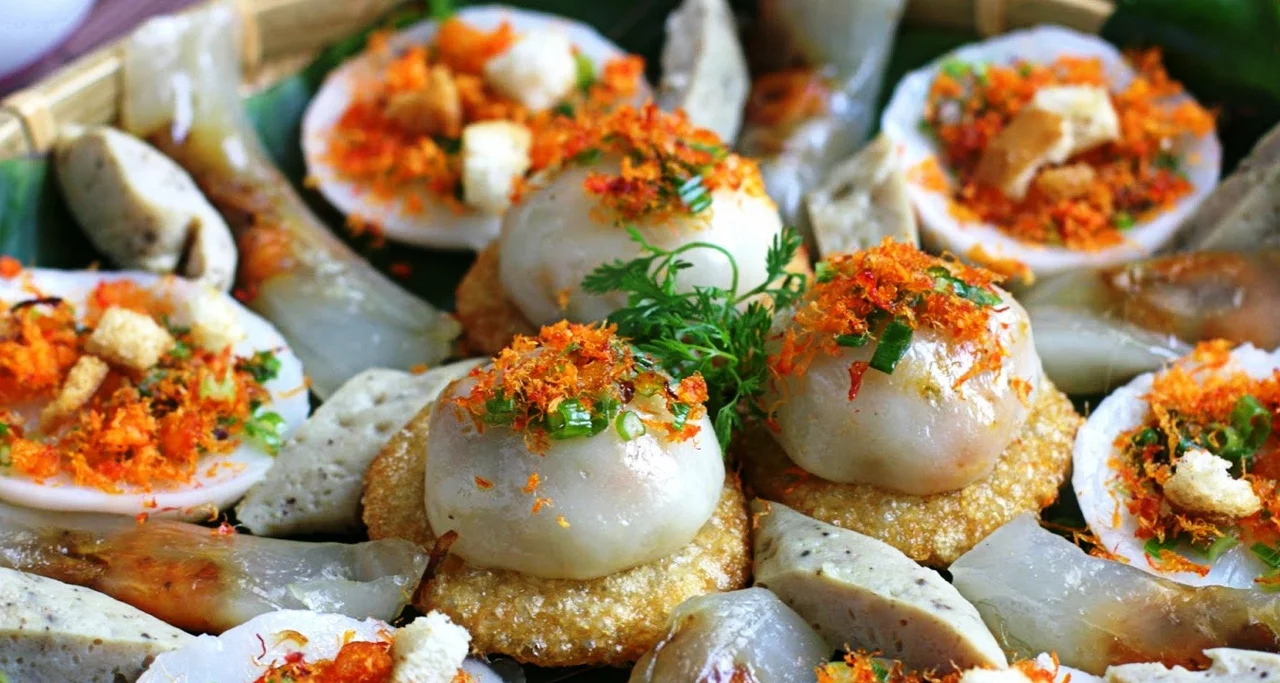
Banh Beo at Banh Beo Ba Do restaurant in Hue City
Central cuisine is known for its pungent taste. Chilies, black peppers and shrimp sauce are commonly used for dishes, making them hotter and spicier. Once the capital of the last dynasty of Vietnam, Hue is considered the cradle of Central cuisine, reflecting the influence of ancient Vietnamese royal cuisine. As a result, culinary in the region is very sophisticated in processing and presentation. Central people also have the habit of eating every meal in small portions like small bowls and small dishes. You can see this feature when trying some kinds of cakes in Central such as “banh bot loc” (tapioca dumpling), “banh beo” (steamed rice cake), “banh it ram” (fried sticky rice dumpling)…
Southern Cuisine – diverse and exotic
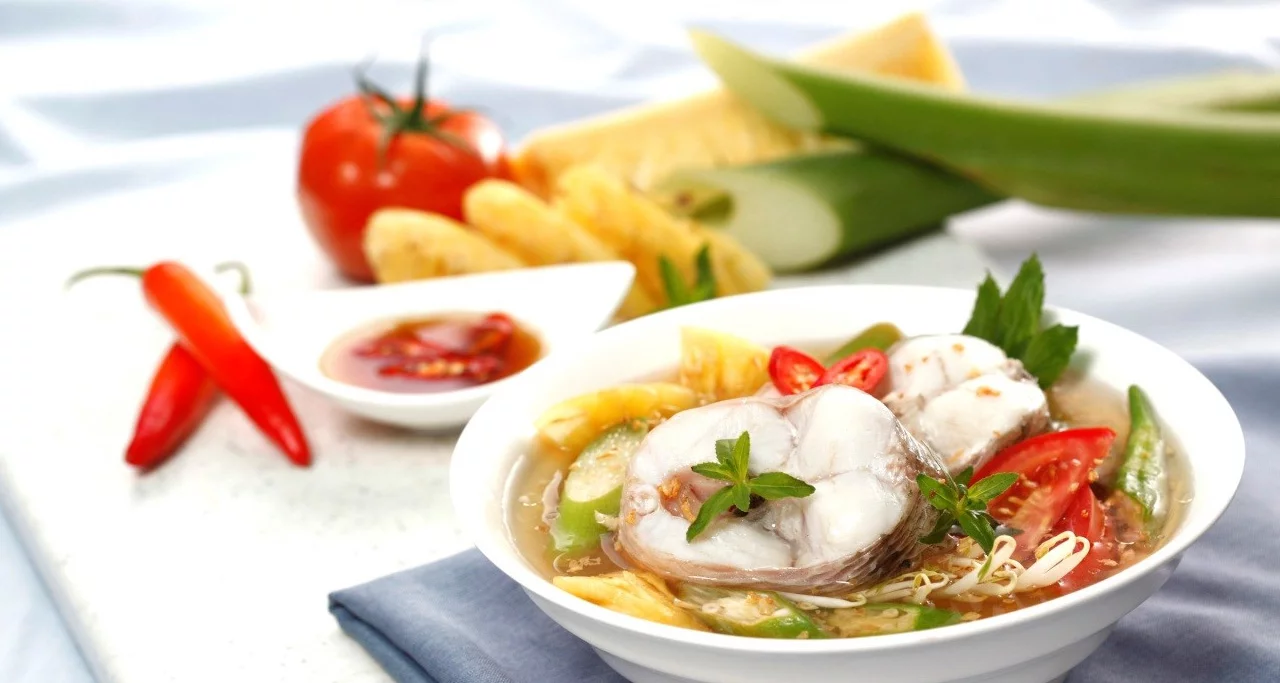
Colorful fish soup at a restaurant in Can Tho city
Southern cuisine has a tendency to taste sweeter than other two regions of Vietnam by adding sugar and coconut milk. Though food in the South is very simple and rustic with short cooking time to remain the freshness of ingredients, it is very diverse, flavorful and seasonal. It is also partly influenced by Chinese, Cambodian and Thai cuisine.
Thanks to the warm weather and fertile soil making the land ideal for a wide variety of fruits, vegetables, livestock and seafood. There are many exotic dishes in South Vietnam, sometimes making you scared to try such as coconut worms, snakes, rats…. Besides, some of other famous specialties in South Vietnam you should not miss are “com Tam” (Vietnamese broken rice), “hu tieu” (pork and seafood noodle soup), “banh mi” (Vietnamese sandwich), “lau mam” (fermented fish hot pot),…
Ethnic Groups
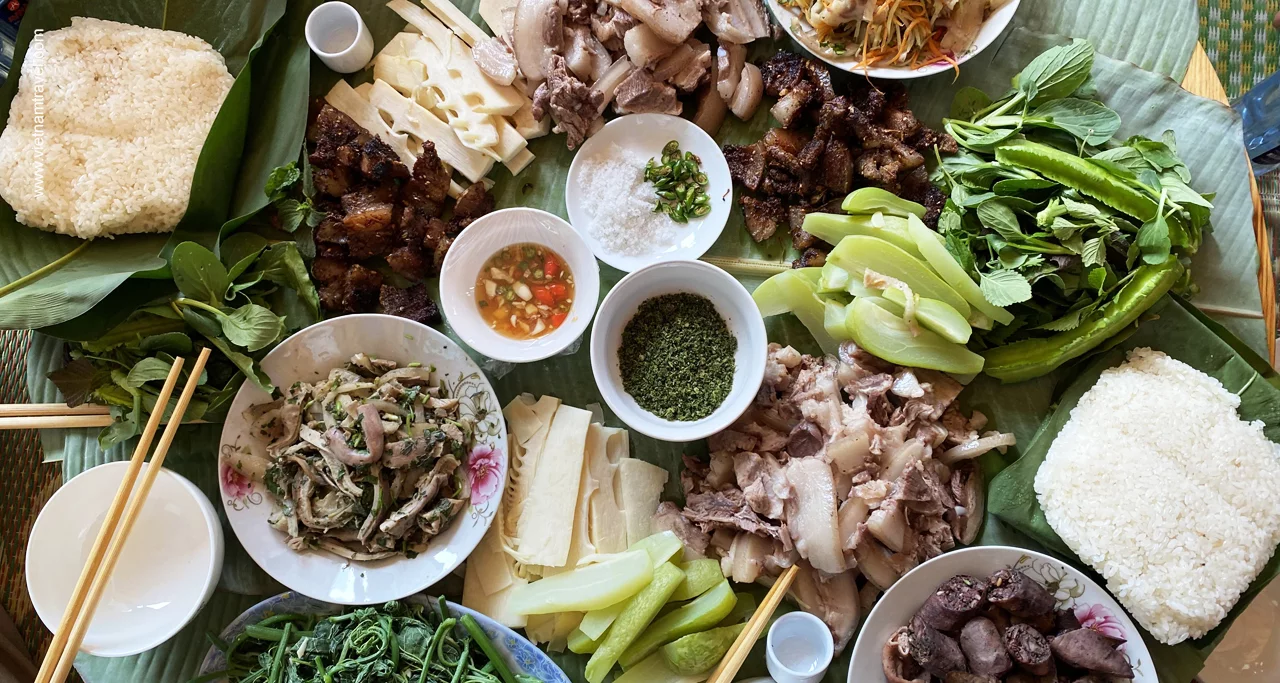
A hosted dinner of Thai tribe in Ngoc Chien village, Muong Ladistrict, Son La province. Cooked by Mr. Phang
Vietnam consists of 54 ethnic groups living in geographical regions nationwide. Each group has its own distinctive tradition and food culture, making Vietnamese cuisine more diverse and richer. Most of ethnic minorities often reside in highlands and remote mountainous areas. Though their foods is not varied, culinary techniques are very unique and not inferior.
Hill tribes in Sapa, Ha Giang,… are famous for five color sticky rice. All colors are made from natural ingredients: baby jack fruit for the red, turmeric for the yellow, pineapple leaf for the green and violet glutinous rice leaf for the purple… The ethnic people have turned the simple dish of rice into a colorful and unique food of the mountainous region. Many other specialties of the Vietnamese ethnic minorities include smoked buffalo meat, grilled piglet with special leaf called “mac mat”, black “banh chung”,…
There is an endless list of famous and delicious dishes in unique Vietnamese cuisine. It is hard to describe it by words except for trying by your own senses. Tantalize your taste buds by joining one of Vietnam’s top culinary tours, which offer an immersive exploration of the country’s diverse and flavorful cuisine.
So let’s plan a trip to Vietnam and spend time to explore this beautiful culinary culture.
 Italiano
Italiano
 English
English

